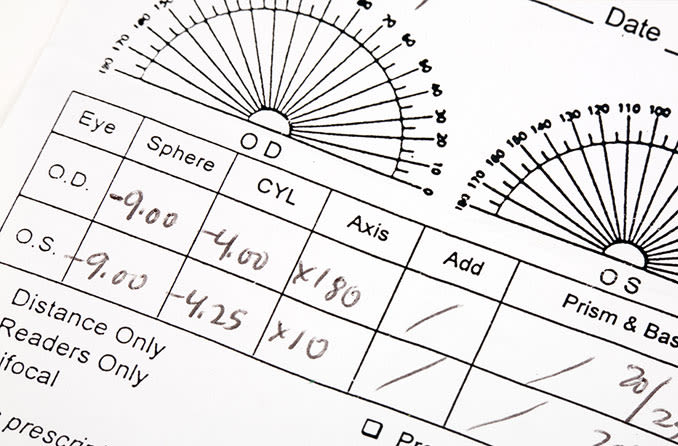- GlassesShop By FrameShop By StyleFeatured












Understanding CYL in Eye Prescriptions: What You Need to Know
Upon acquiring an eye prescription, one might notice the term "CYL" being mentioned. This particular term relates to the cylindrical tube part of the prescription, indicating the endurance of the lens called for to remedy astigmatism. Astigmatism, a typical refractive error, results in covered vision as a result of an irregularly created cornea or lens. The CYL value in the prescription recommends the degree of astigmatism and the equivalent lens power needed to remedy it.

The CYL worth in an eye prescription represents the amount of lens power needed to remedy astigmatism. It is evaluated in diopters and can be either desirable or undesirable, indicating the alignment of the astigmatism. A positive CYL value represents that the astigmatism is oriented at a specific angle, while an adverse CYL worth shows a various orientation.
Understanding the importance of CYL in an eye prescription is essential for getting the correct lenses to deal with astigmatism. The CYL value operates in combination with the sphere (SPH) and axis (AXIS) worths to offer a comprehensive prescription for clear and exact vision. It is important to seek assistance from an eye treatment specialist to make sure that the CYL part of the prescription is properly analyzed and met by the glasses carrier.
One can not take too lightly the importance of CYL in establishing vision modification. CYL, also called cyndrical tube power, plays an essential duty in an eye prescription as it exposes the degree of astigmatism in the eye. Astigmatism emerges when the cornea or lens of the eye is irregularly formed, leading to blurry or distorted vision. The CYL worth in an eye prescription contributes in tackling this problem and providing the necessary correction for unclouded vision.
So, what is CYL in eye prescription, you may ask? Well, it is the dimension that establishes the toughness and angle of the cylindrical lens required to remedy the astigmatism. It is important in making certain that the eye receives the specific adjustment it needs for clear and focused vision.
When one explores the realm of eye prescriptions, one have to acquaint oneself with the significance of CYL, additionally referred to as cyndrical tube. This critical dimension denotes the level of astigmatism present in one's eyes. The devices used to evaluate CYL in eye prescriptions are usually in diopters (D). This measurement functions as an indicator of the level of astigmatism in the eye, with a greater CYL representing a much a lot more considerable level of astigmatism. CYL is identified by the distinction in power in between both major meridians of the eye and is signified as an adverse number for the meridian with the steepest curvature and a favorable number for the meridian with the least curvature.

The influence of CYL on aesthetic clearness is considerable for people with astigmatism. When the CYL value is not correctly addressed in an eye prescription, it can result in distorted or blurred vision, particularly at specific distances or angles. Remedying the CYL component of the prescription with using toric lenses or other specialized eyeglasses is essential for improving aesthetic clearness and total high quality of vision for people with astigmatism.
When analyzing CYL in regard to various other prescription specifications, it is vital to consider the interdependence of CYL with sphere and axis in eye prescriptions. The CYL value, which suggests the level of astigmatism, should be thought about alongside the sphere and axis values to ensure an exact and advantageous prescription. realizing the method these criteria interact is necessary for improving visual quality and general eye wellness.
The measurement of CYL in an eye prescription can be influenced by a wide range of variables. The form of the cornea, the length of the eyeball, and abnormalities in the lens all play a part in figuring out the degree of CYL. Environmental components, such as long term screen time, direct exposure to UV rays, and inadequate lights, can also affect CYL. Moreover, hereditary aspects add to an individual's CYL, as certain eye problems and refractive mistakes can be acquired across generations.
When one considers the rectification of vision, CYL assumes a pivotal role in addressing astigmatism and enhancing overall visual acuity. CYL, also known as cylinder power, is a measure of the extent of astigmatism in an individual's eyes. It contributes to the comprehensive vision correction by rectifying the irregular curvature of the cornea or lens, which can lead to distorted or blurred vision.
CYL contributes to comprehensive vision correction by specifically targeting and rectifying astigmatism, a prevalent refractive error. By addressing the uneven curvature of the cornea or lens, CYL aids in enhancing visual clarity and diminishing the blurriness or distortion caused by astigmatism.
The efficacy of addressing astigmatism through CYL has been substantiated in the improvement of visual acuity. By precisely rectifying the irregular curvature of the eye, CYL lenses or surgery can substantially alleviate or eliminate the symptoms of astigmatism, such as blurry or distorted vision, eye strain, and headaches.
It is of excellent repercussion to comprehend the importance of positive and negative CYL worths when decoding an eye prescription. A favorable CYL value represents the presence of astigmatism, an usual condition that creates obscured vision due to an irregularly designed cornea or lens. On the other hand, a negative CYL value shows the absence of astigmatism. Understanding the CYL worth is vital in identifying the level of astigmatism present in the eye.
Analyzing CYL in conjunction with other prescription parameters is critical for optimizing vision adjustment. The CYL worth, jointly with the round (SPH) and axis worths, supplies a comprehensive understanding of the eye's refractive error. By considering the interplay in between these specifications, eye treatment experts can suggest the most suitable corrective lenses to attend to both astigmatism and various other vision disabilities. It is with this thorough strategy that the most effective feasible vision improvement can be attained.
When one considers the adjustment of the cyndrical tube (CYL) in an eye prescription, there are numerous techniques that might be used to make certain one of the most accurate vision correction. This may involve fine-tuning the cyndrical tube power to achieve one of the most specific prescription for the person.
One method for readjusting the cylinder in an eye prescription is with making use of test frameworks, where various cylinder powers can be tested to establish one of the most suitable choice for the individual. Another approach includes using a phoropter, which allows the eye doctor to make little modifications to the cyndrical tube power while the person offers feedback on their vision. In addition, wavefront modern technology can be made use of to create an individualized prescription that thinks about the unique flaws in the patient's eyes.
Precise cyndrical tube dimension is vital for optimum vision improvement, as even small errors in the cylinder power can result in blurred or misshaped vision. By properly adjusting the cylinder in an eye prescription, clients can experience improved quality and intensity in their vision, causing a far better total visual experience.
Summary of the function and value of CYL in eye prescription
When one considers eye prescriptions, the significance of CYL (cylinder) can not be ignored, as it is vital in remedying astigmatism. It indicates the amount of lens power called for to deal with the uneven curvature of the cornea or lens. Comprehending the value of CYL in eye prescription is important for making sure accurate vision improvement and ideal aesthetic acuity. Optometrists and ophthalmologists thoroughly take right into account CYL dimensions to customize prescriptions that satisfy the unique requirements of each client.
CYL in an eye prescription refers to the cylinder component, which indicates the strength of the lens needed to correct astigmatism. It measures the degree of astigmatism and the corresponding lens power required for correction.
CYL, or cylinder, in an eye prescription addresses the amount of astigmatism present in the eye. A higher CYL value means a greater degree of astigmatism that needs to be corrected, and understanding how CYL affects vision correction is essential for ensuring the right prescription and optimal visual acuity.
Understanding the significance of positive and negative CYL values is crucial in interpreting an eye prescription. Positive CYL values indicate the presence of astigmatism, while negative CYL values signify the absence of astigmatism.
The CYL value works in conjunction with the sphere (SPH) and axis values to provide a comprehensive understanding of the eye's refractive error. Understanding how these parameters interact is crucial for optimizing visual acuity and overall eye health.
High or low CYL in an eye prescription can be caused by factors such as the shape of the cornea, the length of the eyeball, irregularities in the lens, environmental factors, and genetic factors.

